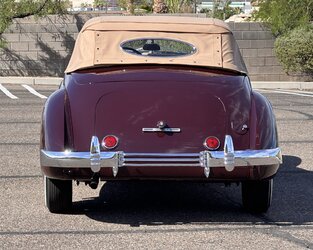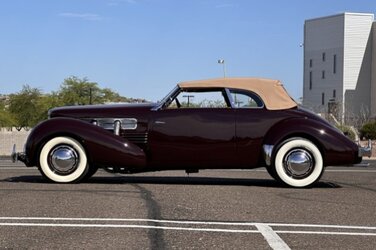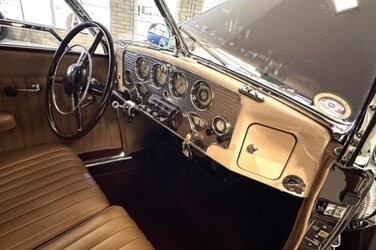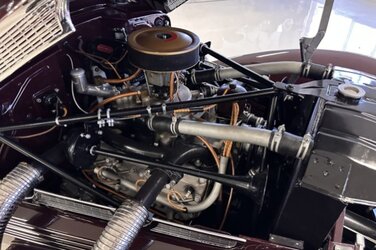Article (Archive)

This 1937 Cord 812 is a supercharged phaeton that is said to have spent time in Texas and Oklahoma in the 1940s before being placed in storage in Louisiana for three decades. Around 1980, the car was removed from storage and sold to a Tennessee owner who commissioned a refurbishment that was performed in Colorado and Indiana from the 1990s to the early 2000s. The car received Auburn Cord Duesenberg Club certification during the project and was certified twice again in 2003 and 2017 before being purchased by its current owner in 2020. Finished in maroon over tan leather, the car is powered by a 288ci Lycoming V8 that was fitted from the factory with a Schwitzer-Cummins centrifugal supercharger and drives the front wheels via a vacuum-operated four-speed preselector transaxle. Additional features include external exhaust pipes, independent front suspension, four-wheel hydraulic drum brakes, manually operated pop-up headlights, fog lights, a tan convertible top, and a radio. This supercharged 812 is now offered on dealer consignment in Arizona with ACD certification documents and a clean Pennsylvania title.

The Cord 810 was introduced in late 1935 for the 1936 model year and returned for 1937 as the 812 before the Auburn Automobile Company ceased manufacture of the Cord marque. Penned by Gordon Buehrig, styling includes a “coffin-nose” front profile with a louvered wraparound grille, a rear-hinged hood, hideaway headlights raised via dash-mounted hand cranks, concealed door hinges, and a split windshield. Six body styles were offered in 1937, each of which was available as a supercharged variant distinguished visually by external exhaust pipes on each side of the hood.

This example’s two-door convertible phaeton coachwork received a repaint in maroon during the refurbishment that is said to have been performed by Cole’s Classic and Antique Autos in Nederland, Colorado, between the 1990s and early 2000s. Features include chrome bumpers with overriders, a driver-side mirror, rear fender stone guards, and a tan convertible top.

Body-color steel wheels wear chrome covers and are wrapped in 6.50-16 Firestone wide-whitewall tires, as is a spare housed in the trunk. Stopping is handled by four-wheel hydraulic drum brakes.

The cabin is trimmed in tan leather over the front and rear bench seats as well as over the door panels and rear side panels. Additional interior features include maroon carpeting, roll-up side windows, retractable rear quarter windows, dual lockable gloveboxes, and a dash-mounted rearview mirror.

The maroon three-spoke steering wheel features a bright horn ring and shares its column with a Bendix “electric hand” gear selector at the driver’s right. A machine-turned dash fascia houses a 150-mph speedometer, a 5k-rpm tachometer, a clock, a rotary-dial radio, and gauges monitoring coolant temperature, fuel level, oil pressure, and amperage. The five-digit odometer shows 200 miles and is said to reflect the distance driven since the refurbishment. Approximately 20 miles have been added under current ownership.

The 288ci V8 features three main bearings, aluminum cylinder heads, and side valves angled at a near-horizontal position and is topped with a Schwitzer-Cummins centrifugal supercharger and a single Stromberg carburetor. A mechanical refurbishment is said to have been performed by Allison Restoration Shop in Auburn, Indiana, between the 1990s and 2000s. According to the selling dealer, the car will require servicing before regular use.

Power is transferred to the front wheels by a Detroit Gear four-speed manual transaxle mounted ahead of the engine. Gear changes are preselected via the column-mounted electrical switch and are set into action when the depression of the clutch pedal completes the electrical circuit that actuates vacuum cylinders on the transaxle unit. Suspension incorporates a trailing-arm independent front setup with a transverse leaf spring and a solid rear axle with semi-elliptical leaf springs.

A 1992 ACD Club certification report lists the component numbers and describes the car as a factory-supercharged example. ACD Club certificates from 2003 and 2017 can be seen in the photo gallery below. The 2003 ACD Club certificate also notes the factory supercharged setup, and an additional certificate from 2017 is presented in the gallery and lists the same serial and engine numbers.

This 1937 Cord 812 is a supercharged phaeton that is said to have spent time in Texas and Oklahoma in the 1940s before being placed in storage in Louisiana for three decades. Around 1980, the car was removed from storage and sold to a Tennessee owner who commissioned a refurbishment that was performed in Colorado and Indiana from the 1990s to the early 2000s. The car received Auburn Cord Duesenberg Club certification during the project and was certified twice again in 2003 and 2017 before being purchased by its current owner in 2020. Finished in maroon over tan leather, the car is powered by a 288ci Lycoming V8 that was fitted from the factory with a Schwitzer-Cummins centrifugal supercharger and drives the front wheels via a vacuum-operated four-speed preselector transaxle. Additional features include external exhaust pipes, independent front suspension, four-wheel hydraulic drum brakes, manually operated pop-up headlights, fog lights, a tan convertible top, and a radio. This supercharged 812 is now offered on dealer consignment in Arizona with ACD certification documents and a clean Pennsylvania title.

The Cord 810 was introduced in late 1935 for the 1936 model year and returned for 1937 as the 812 before the Auburn Automobile Company ceased manufacture of the Cord marque. Penned by Gordon Buehrig, styling includes a “coffin-nose” front profile with a louvered wraparound grille, a rear-hinged hood, hideaway headlights raised via dash-mounted hand cranks, concealed door hinges, and a split windshield. Six body styles were offered in 1937, each of which was available as a supercharged variant distinguished visually by external exhaust pipes on each side of the hood.

This example’s two-door convertible phaeton coachwork received a repaint in maroon during the refurbishment that is said to have been performed by Cole’s Classic and Antique Autos in Nederland, Colorado, between the 1990s and early 2000s. Features include chrome bumpers with overriders, a driver-side mirror, rear fender stone guards, and a tan convertible top.

Body-color steel wheels wear chrome covers and are wrapped in 6.50-16 Firestone wide-whitewall tires, as is a spare housed in the trunk. Stopping is handled by four-wheel hydraulic drum brakes.

The cabin is trimmed in tan leather over the front and rear bench seats as well as over the door panels and rear side panels. Additional interior features include maroon carpeting, roll-up side windows, retractable rear quarter windows, dual lockable gloveboxes, and a dash-mounted rearview mirror.

The maroon three-spoke steering wheel features a bright horn ring and shares its column with a Bendix “electric hand” gear selector at the driver’s right. A machine-turned dash fascia houses a 150-mph speedometer, a 5k-rpm tachometer, a clock, a rotary-dial radio, and gauges monitoring coolant temperature, fuel level, oil pressure, and amperage. The five-digit odometer shows 200 miles and is said to reflect the distance driven since the refurbishment. Approximately 20 miles have been added under current ownership.

The 288ci V8 features three main bearings, aluminum cylinder heads, and side valves angled at a near-horizontal position and is topped with a Schwitzer-Cummins centrifugal supercharger and a single Stromberg carburetor. A mechanical refurbishment is said to have been performed by Allison Restoration Shop in Auburn, Indiana, between the 1990s and 2000s. According to the selling dealer, the car will require servicing before regular use.

Power is transferred to the front wheels by a Detroit Gear four-speed manual transaxle mounted ahead of the engine. Gear changes are preselected via the column-mounted electrical switch and are set into action when the depression of the clutch pedal completes the electrical circuit that actuates vacuum cylinders on the transaxle unit. Suspension incorporates a trailing-arm independent front setup with a transverse leaf spring and a solid rear axle with semi-elliptical leaf springs.

A 1992 ACD Club certification report lists the component numbers and describes the car as a factory-supercharged example. ACD Club certificates from 2003 and 2017 can be seen in the photo gallery below. The 2003 ACD Club certificate also notes the factory supercharged setup, and an additional certificate from 2017 is presented in the gallery and lists the same serial and engine numbers.


